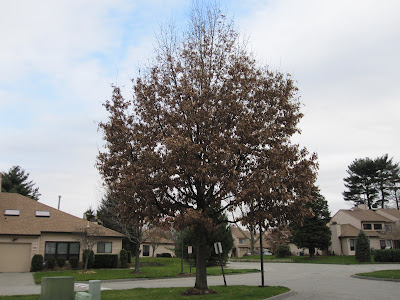
Photo Amy P.
As the holiday season is upon us our thoughts turn to feasting and other indoor activities.
If your a person, who like myself, enjoys the outdoors and wooded areas on a daily basis
stormy winter weather can be particularly frustrating ! Here is a way to fight cabin fever, do a few crafts indoors with friends and family and help wildlife keep warm on those wintry days.
This need not mean making a trip to the craft store if you are handy and have imagination.
A properly adorned Wildlife Tree can attract Blue Jays, Chickadees, Cedar Waxwings, Nuthatch, Woodpeckers and many other seasonal varieties.
While we are all familiar with suet baskets, these can be spruced up by putting rendered suet into onion bags that have been cut into colourful 12inch by 12 inch squares.
You can mix in a few sunflower seeds or other bird seeds as the suet cools to add interest
for the birds. Put the chilled suet in the middle and bring the corners together and tie with cotton butcher cord. Be careful if you use wire or plastic twine as these can damage trees if they are not removed promptly and can injure wildlife if they eat the twine.
Raisin icicles can be made from raisins strung on waxed dental floss. A good sized needle will help to string them and you can store them in a cool dry place until you are ready to place them on your tree.
Frozen cranberries and florist wire can be fashioned into a wreath that will light up your tree and delight wildlife. If you plan ahead you can gather up crab apples and use florist wire to hang them
dumbbell style over branches. If you didn't plan a head you can still cut a few oranges or grapefruits in half and after having a delicious glass of juice fashion these into citrus cups that will brighten up your wildlife tree. After removing the juice and as much pulp as you can punch three holes around the rim of the citrus half and use cotton
or other natural twine to hang the cup from the tree. Store in a cool dry place like the refrigerator for a day or two before filling them with nuts, seeds and other goodies once you hang them on the tree. A small hole near the bottom will keep excess moisture from building up.
These items don't have to be exotic, even a few stems of wheat or barley tied together into a flower cluster, with a small sunflower will attract small birds. Indian corn or whole sunflower heads can be used as well.Pick a tree away from your house and in view of a convenient window, like the one over the kitchen sink to ensure you will have a good view. You can use a spruce tree or other evergreen to give good contrast and some shelter to birds and squirrels that are munching on your bounty.
Assemble all the ingredients and have a wildlife tree trimming party!I have included a picture of a whild life tree that I came across on the grounds of a local college. A great activity for faculty and staff! This could be a great family tradition that you can start the New Year with.
If you have a tree that your not sure about hanging things off of contact your ISA Certified Arborist to see if its sturdy and safe.















